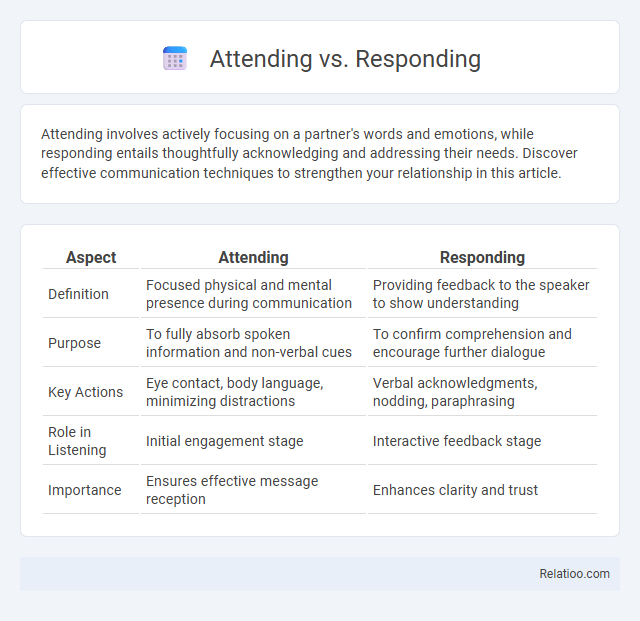Attending involves actively focusing on a partner's words and emotions, while responding entails thoughtfully acknowledging and addressing their needs. Discover effective communication techniques to strengthen your relationship in this article.
Table of Comparison
| Aspect | Attending | Responding |
|---|---|---|
| Definition | Focused physical and mental presence during communication | Providing feedback to the speaker to show understanding |
| Purpose | To fully absorb spoken information and non-verbal cues | To confirm comprehension and encourage further dialogue |
| Key Actions | Eye contact, body language, minimizing distractions | Verbal acknowledgments, nodding, paraphrasing |
| Role in Listening | Initial engagement stage | Interactive feedback stage |
| Importance | Ensures effective message reception | Enhances clarity and trust |
Introduction: Understanding Attending and Responding
Understanding attending and responding is crucial for effective communication, with attending referring to fully focusing your attention on the speaker's verbal and nonverbal cues. Responding involves providing feedback that acknowledges and clarifies the message, fostering mutual understanding and connection. Your ability to balance these skills enhances active listening and ensures meaningful interactions.
Definition of Attending in Communication
Attending in communication refers to the focused and intentional act of perceiving and giving full attention to a speaker's verbal and nonverbal messages. It involves active listening skills such as maintaining eye contact, nodding, and providing feedback that confirms understanding. Unlike merely responding or reacting, attending requires mindful engagement that facilitates effective interpersonal interaction and ensures accurate message comprehension.
Definition of Responding in Communication
Responding in communication refers to the process of providing feedback or reactions to a message to indicate understanding or engagement. It involves verbal or nonverbal cues such as nodding, asking questions, or paraphrasing, which confirm that the listener is actively processing the information. Effective responding enhances the clarity and flow of communication by fostering interaction and ensuring both parties are aligned.
Key Differences Between Attending and Responding
Attending involves giving your full attention through nonverbal cues like eye contact, body language, and facial expressions, which shows you are present in the conversation. Responding goes beyond attending by including verbal feedback, such as asking questions, paraphrasing, or providing comments that demonstrate understanding and engagement. Your ability to effectively combine attending and responding enhances communication, ensuring the speaker feels heard and encourages a more interactive dialogue.
Importance of Attending Skills in Effective Communication
Attending skills are fundamental in effective communication because they involve fully focusing on your conversation partner through behaviors like eye contact, nodding, and open body language. These skills signal to the speaker that you value their message, fostering trust and encouraging open dialogue. Mastering attending techniques enhances your ability to truly understand and respond meaningfully, leading to more successful interpersonal interactions.
The Role of Responding in Interpersonal Interactions
Responding plays a crucial role in interpersonal interactions by actively signaling understanding and engagement, which fosters trust and effective communication. Unlike merely attending, which involves passive listening, responding involves providing verbal and non-verbal feedback that clarifies, affirms, or elaborates on the speaker's message. This dynamic exchange enhances relational depth, reduces misunderstandings, and promotes collaborative problem-solving.
Examples of Attending Techniques
Attending techniques include maintaining eye contact, using open body language, and nodding to show active listening during conversations. Examples of attending behaviors also involve leaning slightly forward, mirroring the speaker's expressions, and providing verbal affirmations such as "I see" or "Go on." These methods enhance communication by demonstrating presence and engagement, which fosters a supportive environment for responding effectively.
Best Practices for Effective Responding
Effective responding requires active listening techniques that include maintaining eye contact, nodding, and providing verbal affirmations to demonstrate understanding. Best practices emphasize addressing the speaker's emotions and content clearly by paraphrasing and asking relevant questions to ensure clarity. Prioritizing empathy and avoiding interruptions create a supportive environment that fosters open communication and trust.
Attending vs Responding in Professional Settings
In professional settings, attending involves actively listening and observing both verbal and nonverbal cues to fully understand the message being communicated, while responding requires providing appropriate feedback or reactions to demonstrate engagement and comprehension. Effective attending improves your ability to accurately interpret colleagues' intentions and emotions, fostering stronger workplace relationships. Your skill in responding thoughtfully enhances collaboration, ensuring that conversations lead to productive outcomes and mutual understanding.
Conclusion: Balancing Attending and Responding Skills
Balancing attending and responding skills enhances effective communication by ensuring you remain fully present while also providing meaningful feedback. Mastering both allows your interactions to be more empathetic and dynamic, fostering deeper understanding and connection. Prioritize developing these complementary skills to improve your personal and professional relationships.

Infographic: Attending vs Responding
 relatioo.com
relatioo.com